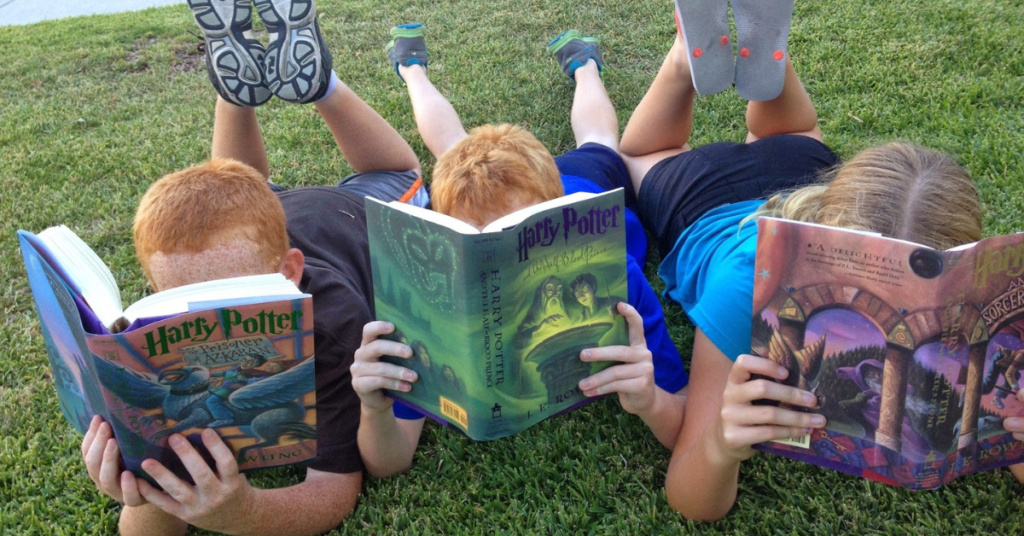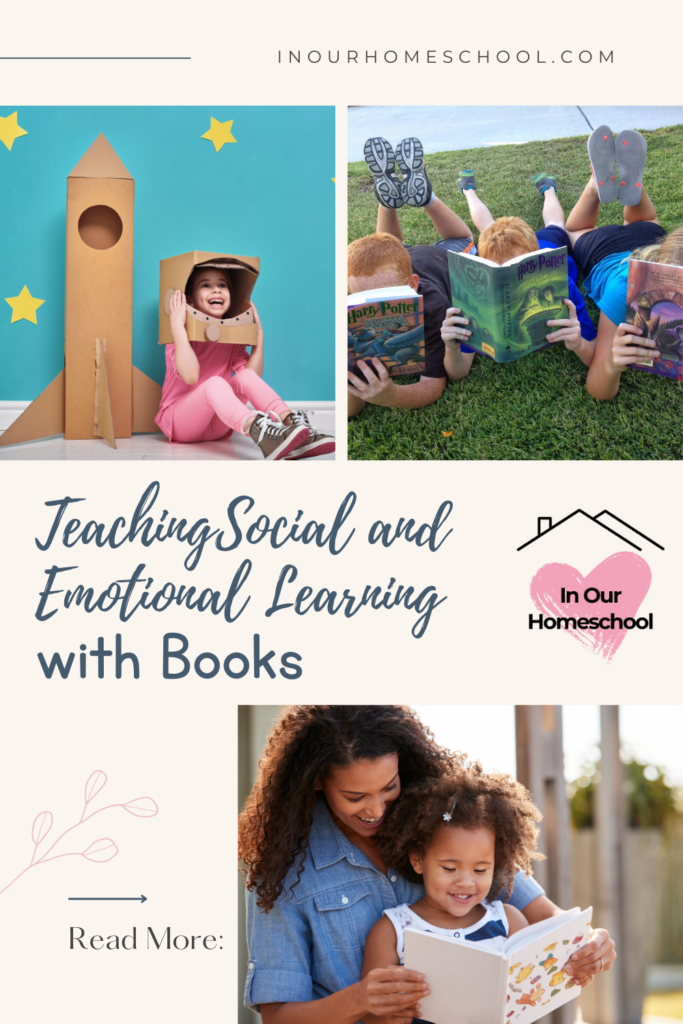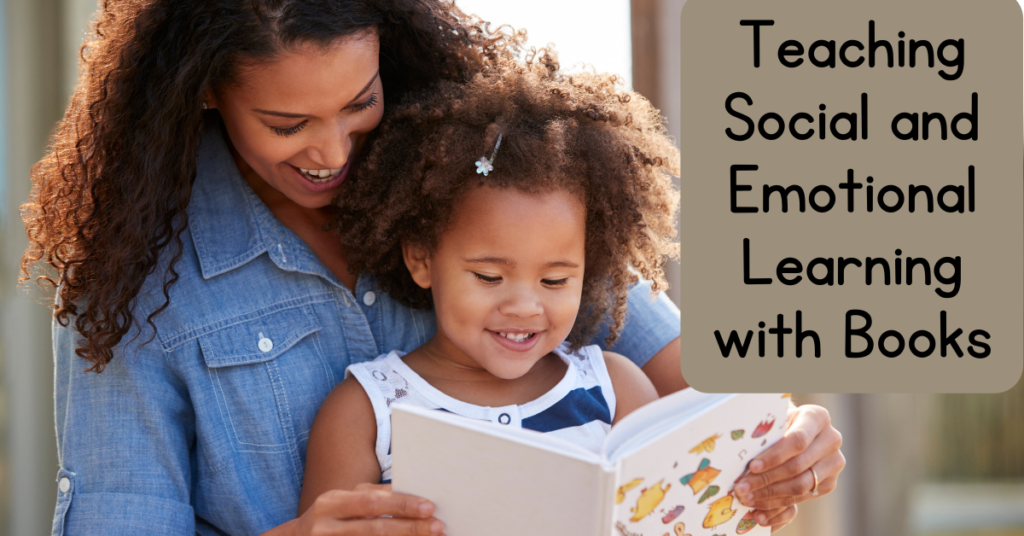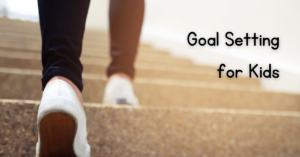If you’ve been following my blog for long, you probably have noticed that I’m all about the books. So much so that my sister, our favorite children’s librarian, shares book recommendations each month! Since that’s the case, today I wanted to share some ideas for teaching social and emotional learning with books.
Okay, okay. I can hear the naysayers… “Are you kidding us Kristen? We’re already being questioned why we bother homeschooling. They think we should send our kids to public school because we’re not trained teachers. And even if we have degrees, they question if we can teach socialization to our kids as homeschoolers. Now you’re telling us that you want to teach it with books?”
And here’s the answer: a resounding “Yes!”
People already know that books can transport you to different places and times, but, have you ever read a book and laughed until it felt like you’d done a hundred sit-ups? Or cried because it was so poignant? (I seriously cannot read Harry Potter and the Deathly Hallows without a box of tissues!) If you’ve done either of these things, it proves the power of books in this sphere.
Teaching Social and Emotional Learning with Books for Toddlers and Preschoolers
Although I plan to share ideas for a variety of ages, it’s important to start learning early and that’s where picture books come in. When our kids are babies, they learn through hearing our voices. It’s not just a way to learn language. It’s also a way to learn about new topics, ideas, and even emotions. I believe this is why most picture books are microfocused on a topic and will stress the emotions and reactions of the characters.
Although the youngest kids won’t be able to respond perfectly, they’re still learning self-awareness, so you can ask them questions and point out similarities between them and the characters (“Look! Do you see his eyes? He has brown eyes just like you!” as you point at the character’s eyes and then at your child’s.)
For the kids who can better communicate, there are many questions you can ask to also emphasize the social awareness aspect of social and emotional learning.
- How do you think they feel?
- How would you feel?
- What could they do differently?
- What do you think will happen?
- How do you think they’ll react?

Teaching Social and Emotional Learning with Books for Early Readers
Once your kids can read, it opens a world of possibilities! A fun aspect of books is how they can be written with a first-person or third-person narrative. And both teach aspects of social and emotional learning.
When I read a book with a first-person narrative, I get to hear the main character’s voice as my own. His or her thoughts become my own. I experience every experience right alongside him or her. I get to feel like I’m part of the story… You see what I did there? It’s the same way for our kids. It brings in a touch of self-awareness alongside the social awareness that a story naturally includes.
The third-person narrative helps our kids understand that other people sometimes think and feel differently than we do. But they sometimes think and feel the same as us even when they look completely different or live far away. This social awareness will help them recognize each sameness and difference in real life as well.
For these early readers, here are some additional ways to emphasize social and emotional learning:
- They can read part of the story and write their own ending?
- They can tell the story back from their perspective or maybe act it out.
- You can read the story together, but change one thing about it and figure out how that would change the story.
Teaching Social and Emotional Learning with Books for More Advanced Readers
Just because our kids get older, that doesn’t mean it’s time to stop using books to teach them social and emotional learning. Along with self-and social awareness, they can also learn some self-management and relationship skills by witnessing the experiences of the characters in their books. Even decision making can be practiced with books.
When I was in school, we would be assigned book reports, but I don’t think they were a substantial learning experience. Sharing the setting, characters, and plot of a book, along with my opinion on if I liked it, was the typical outline for a book report. The problem is that it only ensured that I read the book, not that I processed and learned from it. And with the easy access to the internet that our kids have these days, it wouldn’t even ensure that the book had been read.
In order to substantiate a book report for your kids, you can add in more of the social and emotional learning pieces:
- How do you think the character feels when they’re experiencing that situation?
- Do you think you would feel the same way?
- What would it feel like to live in that time period or location?
- Do you think it feels the same or different from how you feel about when and where you live?
Instead of a written book report, maybe make it a verbal report. Your kid can dress like the character and try to act like them for a few hours. Although you can do these things with any books, it’s probably best to use a biography or an autobiography when you’re focused on social and emotional learning.

Choosing the “Right” Books
If you’re now on board with the idea of using books to teach social and emotional learning, the next big question is, “Which books are the right books?”
Although the most truthful answer is that you can do this with any book, there are some books that will prove to be easier than others. Look for books that focus on emotions. I’d recommend the stronger emotions… look for books that give you a reaction. For example: enjoyment and dislike are emotions, books focusing on these emotions may not provide a strong enough understanding of the feelings for younger kids to really recognize them and learn about them. Moving to pleasure or detestation will more likely feel familiar to those same kids. Kids likely experience enjoyment more often than pleasure and dislike more often than detestation, but the lesser strength of these emotions can mean kids don’t easily recognize the feeling.
Think about it this way – when someone says “how are you?” most of the time the response is “fine” or “good.” But those responses are harder to define. Ask yourself, how does “fine” feel? Then ask yourself, how does “amazing” feel? I bet you’ll have more words to describe “amazing!” It’s the same for kids. If this self-awareness is difficult to define for us as parents and adults, it’ll be hard, maybe even harder, for our kids to do the same.
So strong emotions will help kids more easily recognize and understand them, but they should also be authentic. The situation should warrant the strength of emotions. This will make the book more relatable. Even if a character is completely unlike you or them, find and point out the similarities or choose a different book. Just as the emotions need to be relatable, so do the characters.
I’d also recommend stories with positive messages and ones where the main character displays resilience. Even if you don’t create lessons around these aspects, they will help your child to embody these positive qualities. When a likable character shows that he or she is willing to keep going after what they want and not give up, readers have the opportunity to internalize that message. It’s honestly why I block almost every version of “Johnny Johnny, yes papa” from my kids – in most versions, a question is asked, the answer is a denial that turns out to be a lie, and then the liar laughs. I don’t want my kids to internalize that lying is funny. But kids also internalize the good and positive things.
Last Thoughts
There are tons of ways to teach social and emotional learning. If your family is full of readers, then you can definitely use it to your advantage no matter what homeschool style you follow or create. Readers of all ages can practice social awareness through reading. Plus it just takes a couple of questions to incorporate additional aspects of social and emotional learning. When you’re choosing books, any book can facilitate a good learning experience, but, if you take time to pre-read the books, you may find better choices. A lot of the books Miss Michelle shares about would be great choices. Check them out here.
How do you teach social and emotional learning in your homeschool? I’d love to know! Post a comment below, or subscribe to my newsletter and send me an email!
Thank you for joining us In Our Homeschool!

Disclosure: As an Amazon Associate I earn from qualifying purchases. This post may include affiliate links which means I may earn commissions for purchases made while using my link.




